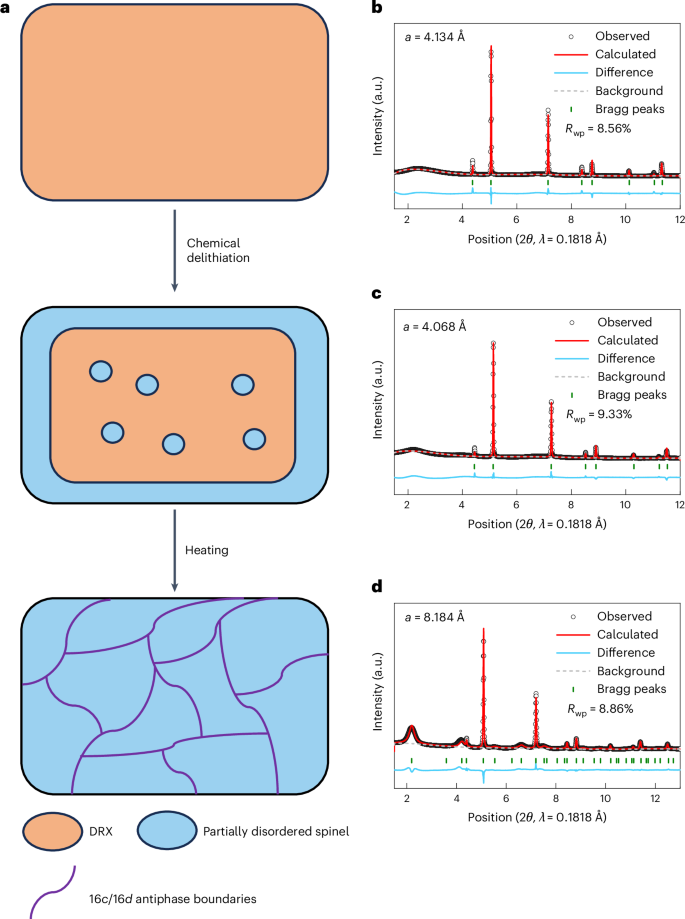具有纳米工程微结构的富地锂离子阴极材料
IF 34.9
1区 材料科学
Q1 MATERIALS SCIENCE, MULTIDISCIPLINARY
引用次数: 0
摘要
锰基材料具有丰富的地球资源、低成本和稳定性,因此具有成为下一代锂离子正极材料的巨大潜力。在这里,我们展示了如何利用锰阳离子的流动性在大颗粒阴极材料中获得独特的纳米微结构,从而增强电化学性能。通过结合原子分辨率扫描透射电子显微镜、四维扫描电子纳米衍射和原位 X 射线衍射,我们展示了当部分脱锰的高锰含量无序岩盐阴极受到轻微加热时,会形成 3-7 纳米大小的部分有序尖晶石畴的纳米马赛克,这些畴在反相边界相互撞击。这些畴的相干长度很短,消除了规则尖晶石在 3 V 附近出现的有害的两相石化反应,并将其转化为固溶体。这种纳米畴结构实现了良好的速率性能,并在平均主颗粒尺寸为 5 µm 的(部分)无序材料中提供了 200 mAh g-1 的放电容量。这项研究不仅拓展了开发高性能富地锰基阴极的合成策略,还从结构上深入了解了纳米工程尖晶石相的能力。本文章由计算机程序翻译,如有差异,请以英文原文为准。


Earth-abundant Li-ion cathode materials with nanoengineered microstructures
Manganese-based materials have tremendous potential to become the next-generation lithium-ion cathode as they are Earth abundant, low cost and stable. Here we show how the mobility of manganese cations can be used to obtain a unique nanosized microstructure in large-particle-sized cathode materials with enhanced electrochemical properties. By combining atomic-resolution scanning transmission electron microscopy, four-dimensional scanning electron nanodiffraction and in situ X-ray diffraction, we show that when a partially delithiated, high-manganese-content, disordered rocksalt cathode is slightly heated, it forms a nanomosaic of partially ordered spinel domains of 3–7 nm in size, which impinge on each other at antiphase boundaries. The short coherence length of these domains removes the detrimental two-phase lithiation reaction present near 3 V in a regular spinel and turns it into a solid solution. This nanodomain structure enables good rate performance and delivers 200 mAh g−1 discharge capacity in a (partially) disordered material with an average primary particle size of ∼5 µm. The work not only expands the synthesis strategies available for developing high-performance Earth-abundant manganese-based cathodes but also offers structural insights into the ability to nanoengineer spinel-like phases. By inducing a transformation in a manganese-rich cation-disordered rocksalt, partially ordered spinels with nanomosaic domains of 3–7 nm in size can be obtained, which exhibit high energy density and rate capability at an average particle size of 3–5 µm.
求助全文
通过发布文献求助,成功后即可免费获取论文全文。
去求助
来源期刊

Nature nanotechnology
工程技术-材料科学:综合
CiteScore
59.70
自引率
0.80%
发文量
196
审稿时长
4-8 weeks
期刊介绍:
Nature Nanotechnology is a prestigious journal that publishes high-quality papers in various areas of nanoscience and nanotechnology. The journal focuses on the design, characterization, and production of structures, devices, and systems that manipulate and control materials at atomic, molecular, and macromolecular scales. It encompasses both bottom-up and top-down approaches, as well as their combinations.
Furthermore, Nature Nanotechnology fosters the exchange of ideas among researchers from diverse disciplines such as chemistry, physics, material science, biomedical research, engineering, and more. It promotes collaboration at the forefront of this multidisciplinary field. The journal covers a wide range of topics, from fundamental research in physics, chemistry, and biology, including computational work and simulations, to the development of innovative devices and technologies for various industrial sectors such as information technology, medicine, manufacturing, high-performance materials, energy, and environmental technologies. It includes coverage of organic, inorganic, and hybrid materials.
 求助内容:
求助内容: 应助结果提醒方式:
应助结果提醒方式:


